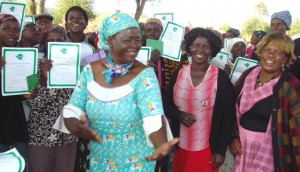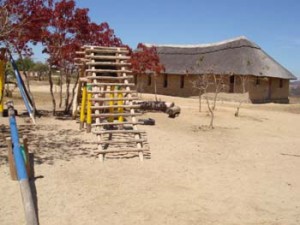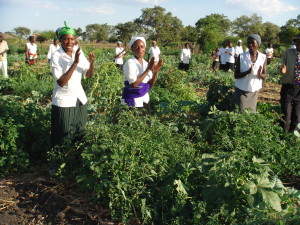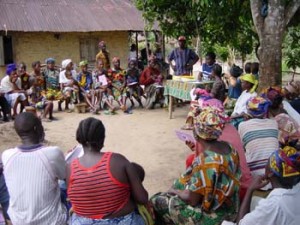Account by Founder
Dr. Juliet Waterkeyn, Co-founder
FIRST OBSERVATIONS IN KENYA
In 1985 my husband Anthony Waterkeyn and I were young development workers working for WaterAid in Kenya, feeling our way in water and sanitation projects.
As an artist drawing training materials I developed a style of ethnographic illustration that ensured even illiterate people could read the pictures well and I spent much time in the villages watching how hygiene was done in the rural homes.
As a young mother, I also related to the need for mothers to have a sense of achievement in their daily activities, as I realiased that just like me, young mothers wanted to excel at our life’s work, caring for our children. From my work with women’s groups in Kenyan villages with the local NGO called KWAHO (Kenya Water for Health Organisation), I saw that mothers do not always understand why children get sick, nor do they realise how much can they themselves can do to prevent so many diseases at little cost and with no reference to anyone else.
However, it is not only knowledge that is needed but the support of the critical mass if change is to be sustained. I had a gut feeling that a kind of sociable ‘club’ would appeal to rural and largely semi-literate women struggling to ensure their family not only survived but prospered.
BRINGING IDEAS HOME
When I returned to my home country in Zimbabwe in 1991, I was determined to put these ideas into practice and approached the Ministry of Health to see if they were interested. They had support from WHO to develop a participatory training kit and so, setting up my Studio AHEAD consultancy for the development of appropriate training materials, I created what were to become the core of the training material which are still used throughout Zimbabwe.
Participatory Hygiene and Sanitation Transformation (PHAST) was a new method of training, and in 1993 was considered the most effective way to ensure behaviour change. However, from what I saw, PHAST did not seem comprehensive enough to really address all the aspects of public health as it comprised for only six sessions of water related activities. I therefore expanded the typical PHAST training to include all preventable disease, such as malaria, bilharzia, skin disease and worms, all of which affects the development and survival of children.
FIELD TRIAL OF THE FIRST CHCs
In 1994, Unicef funded me to try out the first trial of a few Community Health Clubs in Makoni District and Caleb Mwaramba was the first Environmental Health Technician (EHT) in Zimbabwe to test the CHC method. The response he received was overwhelming, and women in their hundreds flocked to clubs in Ruwombe. We thought it was the personal charisma of the trainer, but found the same huge community response when we tried out the same CHC recipe in three other wards in Makoni District. EHTs Morgan Haiza, Evos Makoni and Silas Gwengwe had the same overwhelming response. Some cynics thought it was because the graduating members got T shirts as a reward, but even when we did away with all rewards and subsidies, the people still joined health clubs in droves, and many sceptics could not believe we could attract over 100 people each week for six months of sessions.
On the strength of this success we attracted funding from DfiD, Danida and Oak Foundation to scale up the approach and in 1999, Anthony and I founded Zimbabwe AHEAD Organisation, dedicated to replication of the CHC Approach. DfiD funded a large water and sanitation programme in Tsolotsho and Gutu District , which provided strong evidence of sanitation and hygiene change.
George Nhunhama, Head of the NCU at the time, was our first Chairman and continued as a Trustee, acting as Director in my many absences from Zimbabwe since 2000 until when he retired from the Board in 2009, when Jannette Hetherton, along time supporter from New Zealand Aid became chiarperson, with Anthony as Director.
REPLICATION IN ZIMBABWE
Between 1999 and 2001, Zimbabwe AHEAD demonstrated the cost-effectiveness of what CHCs could do, and set a new benchmark for achieving behaviour change which is often used in the literature, (Waterkeyn & Cairncross, 2005) achieving an average of 47% change in a range of behaviours including total sanitation coverage. We had 400 CHCs in three districts by 2001 (32 in Tsholotosho, 85 in Gutu and 285 in Makoni in 20 wards). Sadly, at this point external funding dried up and this promising start was derailed for the next 6 years while Zimbabwe nose dived into an economic nightmare.
RESEARCH INTO THE CHC APPROACH
However, the CHC model had shown the way, and using my PhD research, I publishing a peer reviewed paper with Prof Sandy Cairncross, Head of the Department at the London School of Hygiene and Tropical Medicine promoted the findings in Zimbabwe and was starting to be recognised internationally. Since then I have spent much time travelling and promoting the CHC Model through Conference Presentations annually at WEDC, as well as World Water Week in Stockholm and University of North Carolina Water and Health Conference . Our second peer review paper, ‘Creating a Culture of Health: Hygiene Behaviour Change in Community Health Clubs through Knowledge and Positive Peer Pressure’ was published in 2013 together with Anthony and this provides much of the rationale for our approach.
HANGING IN DURING NATIONAL COLLAPSE
In Zimbabwe we were only able to keep the process alive thanks to the dedication of Josephine Mutandiro and Andrew Muringaniza who carried the torch through the dark times, often voluntarily giving their time and energy until we began to get funding again in 2007.

With support from New Zealand High Commission and FAO, we ran livelihood programmes which enabled CHCs to start nutrition gardens, keep bees as well as cultivation of herbs. Mrs Josephine Mutandero was the District Coordinator at this time and put the ChC Approach on the map providing enormous support to communities at a time Zimbabwe was crumbling both politically and economically. Thanks to her dedication heading up an extraordinarly team of volunteer ward co-ordinators, Makoni District was greened with over 1,000 communal nutrition gardens, 4,000 individual gardens and 5,000 bee keepers.
In the height of recession the team headed by Andrew Muringaniza helped ten of the CHCs build a training centre near Rusape where ZA was based.


The fact that cholera largely passed by this district was attributed by the PEHO to the density and strength of the many CHCs, and their ability to regroup in time of crisis, and take measures to prevent the spead of cholera, as they recognised the symptoms and knew how to prevent transmission by handwashing with soap, no sharing of food and drink, and the identification of cases who were hospitalised early before passing on the cholera.
When Anthony took over from me as Director in 2008, he secured much needed funding from Mercy Corps and the Zim AHEAD office moved back to Harare. By partnering with other International NGOs such as OXFAM, we managed to keep our organisation alive. However, the next few years saw mainly emergency funding which allowed for little capacity building of the organisation itself and manyof our few assets such as our two large trucks and one vehicle were spent in this effort.

With British Lottery Funding / EU funding through Mercy Corps, Zim AHEAD started 126 CHCs in Manicaland, with 10,706 members, in Chipinge, Chiredezi and Buhera. Throughout this time we kept monitoring the results and accumulated increasing evidence not only of the cost-effectiveness of the approach but also that it could be used in an emergency context to combat cholera, and in urban areas to support municipality and tackle the ever increase public health threat of lack of safe water, sanitation and disposal of solid waste in Zimbabwe’s towns.

Our CHCs cleaned up Chiredzi Town in 2010, Masvingo Town 2011, Mutare in 2012, and Chipinge Town and Bindura in 2013. ‘Seeing is believing’ and more and more NGOs were beginning to adopt our style of community mobilisation.
REGIONAL REPLICATION
In 2005, now based in Cape Town, we decided to start up Africa AHEAD, an international organisation to be an advocacy and training wing of the implementing organisation Zimbabwe AHEAD. We registered in South Africa and as consultants working out of Cape Town we transferred the skills of the CHC Model to many countries in Africa.

In 2001 we started CHCs through Care International in Sierra Leone in two District (Bo and Moyamba). Many other NGOs took up this initiative and by 2005 they had produced a manual for CHCs which used the clubs to build social cohesion after the devastating civil war. We returned years later in 2014 to conduct an evaluation of health promotion methods in the country which had largely adopted CLTS. However CARE was still using the CHC concept in child health programmes and finding it effective in mobilising and reducing disease according to an assessment in 2007.

In 2006, I was asked by philanthropist Peter Boone to assist Effective Interventions in two district of Guinea Bissau to see if infant mortality could be reduced using CHCs. During the next two years 80 clubs were started, and performed well as descried in the paper they published in 2016.
From 2007 -2010, Africa AHEAD concentrated on work in South Africa, training municipal workers who eventually started over 400 CHCs in the informal settlements around Cape Town. Funded by Danida we also started a small pilot project in Umzimkulu in Kwa Zulu Natal, and a trial in an informal settlement north of Durban.
From 2009 – 2011, we were engaging in Asia, and developed training package for Vietnam, training the core national trainers who started a successful programme in three Provinces.
We also did a small demonstration project in Namibia with CURVE Waters and ISOE to show how CHCs can be used in high density suburbs to manage ablution blocks. Regis Maitmati trained for other NGOs in other countries such as Namibia, Zambia, Malawi and South Sudan.
The most successful scale up to date has been in Rwanda where from 2010, the Ministry of Health adopted the approach nationwide in the Community Based Environmental Health Promotion Programme, starting up in all 14,000 villages. To-date (2014) 30% of all the villages have had training and the scale up is on-going.
In 2012 the Gates Foundation agreed to fund a Randomised Control Trial to test the cost effectiveness of the CHC Model in the prevention of disease. This continued until 2016, when the results werre published, showing results which were less impressive than expected. However, Africa AHEAD continued for two further years and continued to monitor hygiene behaviour which by the end of 2017 showed results comparable to Zimbabwe.
In 2013, we opened in Uganda working with International Lifeline Fund to compliment their successful water project in Apac District by adding the CHC component to achieve hygiene behaviour change.
PARTNERING WITH OTHER NGOs IN ZIMBABWE
In 2012, DFID’s Protracted Relief Programme (PRPII) commissioned Zim AHEAD to train 22 local and international NGOs in the country. This training enabled the CHC process to spread, although there were some challenges. There was no follow up so the outcomes were unrecorded and we still do not know exactly the numbers who benefitted from the many CHCs which were started by other NGOs.
Apart from Zim AHEAD records, there is little institutional memory of the extent and location of these organised communities. Opportunities to use organised communities have been wasted and the numerous NGOs are operating in isolation from the Ministry of Health and therefore cannot not hope to scale up effectively despite the strength of the CHC training. We are still battling to grow the organisation to match the strength of our ideas, but at last we have done two large programme that were worthy of the scale that can be achieved with CHCs.
In 2011– 2012, Action Contra la Faim (ACF) had the vision to try for a blanket coverage of CHC members in 10 wards in Gutu and Mberengwa. The results were the highest ever achieved by the CHC Model. In one year alone, 83.5% of the households in 457 CHCs had been formed in 427 villages with 17,578 members and 73,827 beneficiaries. Unsubsidized VIP Latrine construction increased by 24% with 90% compliance of 11 recommended hygiene practices (see page 12).
The following year (2013), whilst ACF provided subsidies for the vulnerable households without latrines, Zim AHEAD went on to start 52 School Health Clubs in the same area, so as to ensure generations to come will maintain the standards their parents now practice.
After three years trying to meet compliance stands for direct funding, USAID finally funded Zim AHEAD directly to carry out a one year Cholera Mitigation program which reached 368 villages in Chimanimani, Chipinge and Mutare. In one year, therefore, our organisation was coordinating 883 Community Health Clubs with a total of only 30 dedicated staff for as low as US$2.34 cost per beneficiary!
The original vision of cost-effective sustainable development lives on under the invaluable leadership of Regis Matimati, was Acting Director, building up the visibility of the organisation with his strong advocacy skills. He was suitably supported by Programme Manager, Andrew Muringaniza (the longest serving employee with Zim AHEAD for 15 years) who heads the field team. The success in the past few years can be attributed to Andrew’s ability to make things work in the field. He wins ‘Worker of the Year 2013’ for his quiet organisation and infinite patience in the field, achieving all targets despite the hurdles of the past year.
In 2013, Africa AHEAD was registered as a UK Charity, with a pretigious Board of Trustees, headed by our first international Chairman Prof. Sandy Cairncorss, with Richard Bennison as Secretary to the Board, and Lyle Aitkin as Financial Advisor, with Trustees Barbara Evans and Jannette Hetherton.
Between 2014 and 2017 Africa AHEAD was supported by the Bill & Melinda Gates Foundation in Rwanda, where a Randomised Control Trial was conducted on the CHC approach as it was implemented in the Community Based Environmental Health Promtion Programme. I became CEO, with Anthony as Director of Advocacy, with a Country Director in Rwanda, Joseph Katabarwa, and Country Director in Zimbabwe being Regis Matimati.
In 2014 Africa AHEAD was registered in Zimbabwe as a Private Voluntary Organisation and whilst Zimbabwe AHEAD continued as a local organisation.
In 2017 the RCT was completed and the programme in Rwanda was closed, leaving Zimbabwe as the main focus of operations for the Region. Anthony took over as CEO, but funding was hard to come by for Zimbabwe based in the UK and so in 2019 the UK Board decided to close down as a UK Charity and to move the main office to Southern Africa, so as to be better placed to source regional funding.
When Anthony retired in December 2019, Regis was appointed Executive Director, and took over the leadership of Africa AHEAD based in Zimbabwe. Juliet and Anthony retire from management but remain on the Board of Trustees in Zimbabwe, with Dr. Jaap Kuiper as Chairman. In the same year, Regis suceeded in raisisng almost one million US$ for 6 emergency projects, mainly in Chipinge to assist those made homeless by Cycone Idai, with 75 homes being constructed. With this support over 500,000 people were assisted in one year, largely due to vast handwashing campaigns at the bus termini in Harare where handwashing facilities was provided for all those leaving the capital, with the effect of curtailing the spread of cholera. By the end of the year 2019, Zimbabwe had reached 1.4 million people in the past five years: the only country to have met the 5×5 challenge set in 2013.
.
